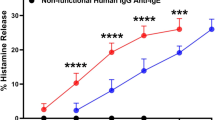Summary
Degranulation of IgE-sensitized rat mast cells by antigen was studied quantitatively in vitro and in vivo by electron microscopy. The inhibition of this degranulation by an anti-allergic drug, N-(3,4-dimethoxycinnamoyl)anthranilic acid (Tranilast), was also examined both in vitro and in vivo. In the in vitro study using peritoneal mast cells, alteration of the granules, cavity formation by fusion of the perigranular membrane and granule discharge due to fusion of the cavity membrane with the cell membrane were observed and were accompanied by histamine release. Scanning electron microscopy disclosed the extrusion of smooth, round bodies from pores formed on the cell surface. In the in vivo study of passive cutaneous anaphylaxis (PCA), the characteristic features of mast cell degranulation were obvious 5 min after the injection of antigen; leakage of dye increased progressively from 5 to 30 min but was not found at 6 h. From quantitative analysis of the substructure of mast cells, it was demonstrated that degranulation of IgE-sensitized mast cells induced by antigen was achieved by sequential exocytosis both in vitro and in vivo. Tranilast inhibited these changes to a remarkable extent and it was concluded that the inhibition of mast cell degranulation by this drug might play an important role in anti-allergic treatment.
Similar content being viewed by others
References
Anderson P, Slorach SA, Uvnäs B (1973) Sequential exocytosis of storage granules during antigen-induced histamine release from sensitized rat mast cells in vivo. An electron microscopic study. Acta Physiol Scand 88:359–372
Azuma H, Banno K, Yoshimura T (1976) Pharmacological properties of N-(3′,4′-dimethoxycinnamoyl)anthranilic acid (N-5′), a new anti-atopic agent. Br J Pharmacol 58:483–488
Baxter JH, Admik R (1978) Differences in requirements and actions of various histamine-releasing agents. Biochem Pharmacol 27:497–503
Berlin G (1984) The dynamics of mast cell secretion mediated by IgE or polyamines. Agents Actions 15:482–487
Bloom GD, Haegermark O (1965) A study of the morphological changes and histamine release induced by compound 48/80 in rat peritoneal mast cells. Exp Cell Res 40:637–654
Ishizaka K, Ishizaka T (1967) Identification of γE antibodies as a carrier of reaginic activity. J Immunol 99:1187–1198
Ishizaka K, Ishizaka T (1970) Biochemical function of γE antibodies and mechanisms of reaginic activity. Clin Exp Immunol 6:25–42
Ishizaka T, Ishizaka K, Tomioka H (1972) Release of histamine and slow reacting substance of anaphylaxis (SRS-A) by lgEanti-IgE reaction on monkey mast cells. J Immunol 108:513
Katayama S, Shionoya H, Ohtake S (1978) A new method for extraction of extravasated dye in the skin and the influence of fasting stress on passive cutaneous anaphylaxis in guinea pigs and rats. Microbiol Immunol 22:89–101
Kazimierczak W, Diamant B (1978) Mechanisms of histamine release in anaphylactic and anaphylactoid reactions. Prog Allergy 24:295–365
Koda A, Nagai H, Watanabe S, Yanagihara Y, Sakamoto K (1976) Inhibition of hypersensitivity reactions by a new drug, N(3′,4′-dimethoxycinnamoyl)anthranilic acid (N-5′). J Allergy Clin Immunol 57:396–407
Koda A, Kurashina Y, Nakazawa NM (1985) The inhibition mechanism of histamine release by N-(3,4-dimethoxycinnamoyl)anthranilic acid. Int Arch Allergy Appl Immunol 77:244–245
Krüger PG, Bloom GD (1974) Structural features of histamine release in rat peritoneal mast cells. Int Arch Allergy 46:740–752
Kulczycki AJr, Metzger H (1974) The interaction of IgE with rat basophilic leukemia cells. II. Quantitative aspects of the binding reaction. J Exp Med 140:1676–1695
Lagunoff D (1972) The mechanism of histamine release from rat mast cells. Biochem Pharmacol 21:1889–1896
Lagunoff D (1973) Membrane fusion during mast cell secretion. J Cell Biol 57:252–259
Lagunoff D, Martin TW, Read G (1983) Agents that release histamine from mast cells. Ann Rev Pharmacol Toxicol 23:331–351
Luft JH (1961) Improvement in epoxy resin embedding methods. J Biophys Biochem Cytol 9:409–414
Nishigaki T, Momose Y, Nagata T (1986) Electron microscopic radioautographic studies on the localization of an anti-allergic agent, tranilast, in rat mast cells. Proc Xlth Int Congr on Electron Microsc, Kyoto, pp 2289–2290
Read GW, Kiefer EF (1979) Benzalkonium chloride: selective inhibitor of histamine release induced by compound 48/80 and other polyamines. J Pharmac Exp Ther 211:711–715
Röhlich P, Anderson P, Uvnäs B (1971) Electron microscope observations on compound 48/80-induced degranulation in rat mast cells. J Cell Biol 51:465–483
Schwartz LB, Austen KF (1984) Structure and function of the chemical mediators of mast cells. Prog Allergy 34:271–321
Shore PA, Burkhalter A, Cohn VHJr (1959) A method for the fluorometric assay of histamine in tissues. J Pharmac Exp Ther 127:182–186
Tada T, Okumura K (1971) Regulation of homocytotropic antibody formation in the rat. I. Feed-back regulation by passively administered antibody. J Immunol 106:1002–1011
Tizard IR, Holmes WL (1974) Degranulation of sensitised rat peritoneal mast cells in response to antigen, compound 48/80 and polymyxin B. Int Arch Allergy 46:867–879
Uvnäs B (1974) The molecular basis for the storage and release of histamine in rat mast cell granules. Life Sci 14:2355–2366
West GB (1982) Histamine release from isolated and intact mast cells of two types of genetically different rats. Agents Actions 12:98–100
West GB (1984) Histamine release from mast cells of the rat. Int Arch Allergy Appl Immunol 74:278–280
Yamasaki H, Fujita T, Ohara Y, Komoto S (1970) Electron microscope studies on the release of histamine from rat peritoneal mast cells. Arch Histol Jpn 31:393–408
Author information
Authors and Affiliations
Additional information
Part of a thesis submitted to Shinshu University School of Medicine in partial fulfilment of the requirements for the Ph.D. degree in Pathology
Rights and permissions
About this article
Cite this article
Nishigaki, T. Mast cell degranulation and its inhibition by an anti-allergic agent tranilast. Virchows Archiv B Cell Pathol 55, 311–322 (1988). https://doi.org/10.1007/BF02896590
Received:
Accepted:
Issue Date:
DOI: https://doi.org/10.1007/BF02896590




